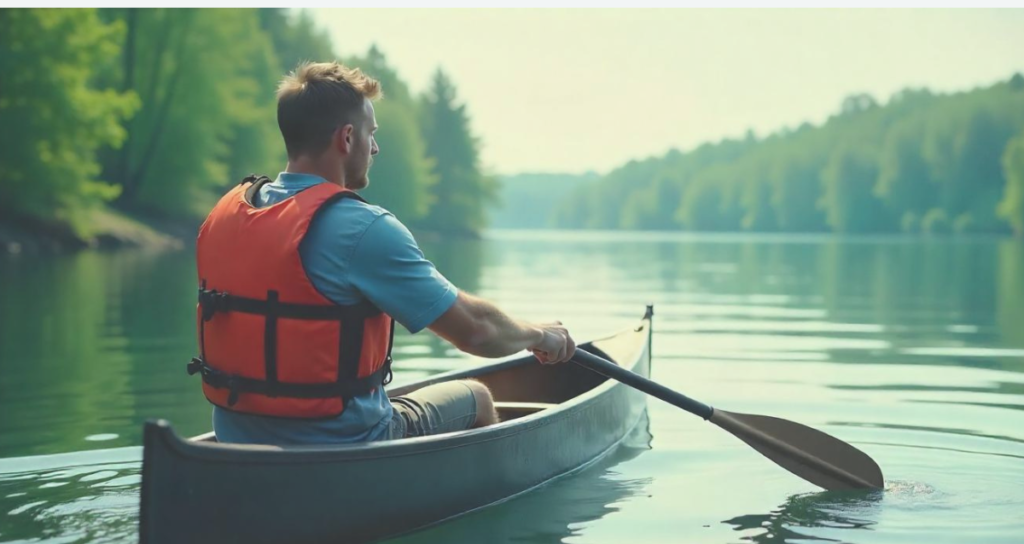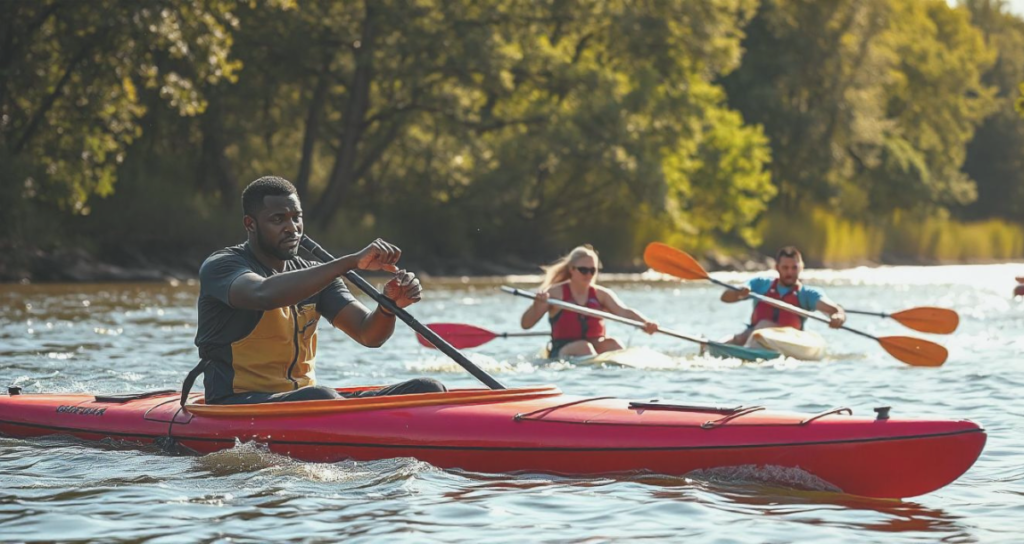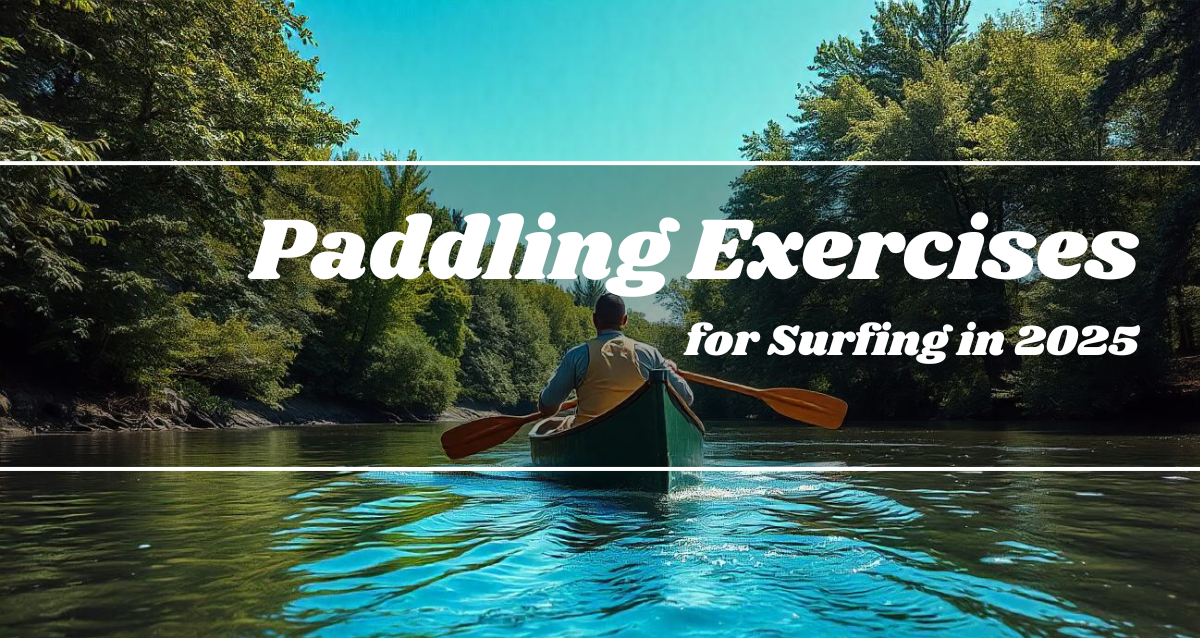Have you ever watched surfers glide effortlessly over the waves and thought, “I wish I could do that”? The truth is, a lot of what makes surfing look so easy happens long before you catch your first wave. One of the most important skills in surfing is paddling, and like any sport, it takes practice to get better at it. But don’t worry! You don’t need to be a pro to start improving your paddling technique. With a few fun exercises, you can build strength and endurance while enjoying the process.
Surfing is a exciting water sports, thats requires someimportant Paddling skill that every surfer should master. This is the foundation of every good wave ride. Its not matters if you’re a beginner or Professional surfer, looking to improve your paddling technique, Enhancing your paddle power can increase your surfing performance. I can tell you some Best paddling exercises, how to paddle your way to better surfing.
Why Paddling Strength Matters
When you hit the waves, it’s not just your board that needs to be in top shape; your body also requires a solid foundation. Paddling strength is crucial for surfers who want to maximize their performance and enjoy longer sessions without burning out. Think about it: every wave you catch begins with that powerful stroke. Building endurance in your shoulders, back, and core translates directly into more effective paddling, enabling you to quickly paddle into position and catch those elusive sets.
But let’s not overlook the mental aspect of developing paddling strength. As you engage in tailored paddling exercises for surfing—like resistance band pulls or bench dips—you’re doing far more than improving physical capabilities; you’re nurturing resilience and confidence. The ocean has a unique way of testing our limits, but when you’re conditioned to paddle through rip currents or make that last sprint for a wave, the empowerment gained from hard work becomes evident. Imagine battling fatigue as you find yourself charging through conditions that would have previously intimidated you; it’s exhilarating. So next time you’re considering skipping a workout session, remember: every bit of effort invested in building your paddling strength pays off on surf day!
Basic Paddling Technique Explained
To master the waves, perfecting your paddling technique is crucial—a skill that transcends mere exercise and transforms into an art form. Think like yourself lying flat on your board, arms extended, ready to propel yourself forward like a torpedo cutting through water. Engaging your core is not just about stability; it’s about creating a seamless flow of energy from your torso down to your hands. As you dip the paddle into the ocean, think of each stroke as drawing power from that core connection rather than just muscular effort.
Timing is another essential element that can elevate how effectively you catch those magical waves. Instead of frantically splashing with each stroke, feel the rhythm of both sea and surf beneath you. Let each pull be deliberate—engage the water fully and let it guide you back toward shore on those smaller whitecaps or deeper swells alike. And don’t overlook breath control; mastering deep inhalations helps keep you calm in challenging conditions while fueling those longer paddling sessions for surfing standouts. With practice and mindfulness in these basics, you’ll find that every invaluable moment spent honing these skills will translate into exhilarating rides come wave time!

Key Muscles Used in Paddling
When you dive into paddling, whether for surfing or fitness, the power centers around your core, shoulders, and back. The rotator cuff muscles play an essential role in maintaining shoulder stability as you reach forward with each stroke. This dynamic engagement not only enhances your paddling efficiency but also safeguards against injuries—a crucial consideration for surfers who need to maintain peak performance over long sessions.
Effective Stretching for Paddle Readiness
As a passionate paddler, I’ve discovered that effective stretching not only prepares my body for the demands of the waves but also enhances my overall performance. While many focus solely on strength training, incorporating specific paddling exercises into your warm-up routine can yield remarkable benefits. Simple dynamic stretches targeting the shoulders, back, and core—like arm circles and torso twists—can increase flexibility and mobility. These movements help in engaging muscles that often remain dormant when we focus primarily on conventional workouts.
Another game-changer for me has been recognizing the role of breathing in stretching. Deep, mindful breaths while holding stretches not only fosters a deeper connection to your body but also calms the mind, sharpening mental clarity for those intense surf sessions ahead. Imagine embracing each wave with a sense of readiness stemming from both physical and psychological preparedness. Ultimately, it’s about creating a ritual that combines movement with mindfulness—this unique approach has transformed my paddle readiness into an enjoyable prelude to surfing adventures!
Simple Paddle Drills to Try
One of my favorite paddling exercises for surfing is the “Catch and Release” drill. Picture this: you’re lying on your board, arms outstretched, and with intentional movements, you simulate catching a wave by pushing yourself forward through the water. The goal is to concentrate on your technique—keeping your elbow high and engaging your core as you paddle. This exercise not only builds strength in your shoulders but also enhances your muscle memory for those moments when you need a quick burst while vying for that perfect wave.
Another effective drill I’ve incorporated into my routine is the “Torpedo Paddle.” It’s simple yet powerful: tuck down low onto your board, using just one arm to propel yourself while keeping the other resting alongside. Switch arms every 30 seconds to maintain balance across both sides of your body.
This drill helps develop unilateral strength and simulates shifting dynamics when taking off on a wave. Trust me, mastering these paddle drills transforms not just how strong you feel in the water but also how swiftly you can respond when that coveted swell rolls in!
How to Get Better at Rowing While Surfing?
Getting better at rowing requires a mix of training, strength preparing, and strategy improvement. The following are a couple of key tips to upgrade your rowing skill:
Work on Rowing Routinely
The most effective way to get better at rowing is by investing however much energy in the water as could be expected. Work on rowing on level water, in the surf, and in any event, during warm-ups.
Work on Your Perseverance
Surfers frequently need to paddle significant distances to arrive at the ideal place in the surf zone. Chipping away at your cardiovascular wellness will work on your capacity to paddle longer and all the more productively.
Adjust Your Stroke
Center around the subtleties of your rowing strategy. Work on the length of your strokes, keeping your developments as smooth and reliable as could really be expected.
Using a Surfboard at Home
Transforming a surfboard into your home workout companion can be both innovative and immensely rewarding. Imagine using it for paddling exercises that mimic the fluid movements of gliding through the ocean waves. By laying on your board on a soft surface, you can engage your core and upper body, replicating the strokes you’ll rely on once you’re out in real water. This not only builds strength in key muscles but also helps improve your paddling technique; the more you practice at home, the more second nature it will feel when you’re actually surfing.
Incorporating Yoga for Balance and Flexibility
Incorporating yoga into your routine as a paddling exercise for surfing can unlock a new dimension of balance and flexibility that directly enhances your performance on the waves. As surfers, we often focus on upper body strength and endurance to power through those paddleouts, yet it’s our core stability and limb fluidity that truly set us apart in the water. Yoga isn’t just about stretching; it teaches mindfulness and breath control, both of which are essential when you’re navigating shifting currents or catching a wave.
Tracking Your Progress Over Time
Tracking your progress over time in paddling exercise for surfing isn’t just about counting strokes or timing sessions; it’s about understanding the journey you’re on. Imagine keeping a journal where each entry reflects not only your achievements but also the moments of struggle and triumph. Photography and video can be invaluable tools, allowing you to visually measure improvements in technique, strength, and even confidence as you navigate through those lull periods on flat water or face challenging waves.
Another fascinating perspective is to incorporate mindfulness into your progress tracking. Rather than fixating solely on numbers or metrics, focus on how each session makes you feel physically and mentally. Are you more energized? Is catching that wave becoming effortless? By noting these personal insights alongside traditional measurements, you’ll cultivate a deeper connection to the water and yourself. This holistic approach encourages growth both in skill and self-awareness, transforming every paddling session into an opportunity for reflection and evolution.
Additional Tips for Strength
What Is the Best Activity for Rowing Strength?

There is nobody size-fits-all activity for rowing strength, however a few activities will assist with further developing your rowing power. The key muscles associated with rowing are your arms, shoulders, back, and center. The best activities for rowing strength include:
Push-ups: Extraordinary for developing chest area fortitude, particularly in the arms and shoulders.
Obstruction Band Columns:
Viable for copying the rowing movement and developing upper back fortitude.
Supermans:
These assistance to reinforce your lower back and center, the two of which are fundamental for equilibrium and power in the water.
What Muscles Are Utilized in Rowing Surfing?
Rowing for surfing draws in an assortment of muscle bunches in the body. The essential muscles included are:
Shoulders:
Your deltoids help you lift and move your arms during each stroke.
Arms:
Biceps and rear arm muscles are key for the pulling and pushing movements while rowing.
Back:
Your upper back muscles, including the lats, assist with the pulling movement, while the lower back settles your body.
Center:
Connected all through the oar to settle your body and keep up with control.
Chest:
Your chest muscles are likewise utilized as a feature of the pushing movement during each stroke.
What Is the Best Exercise for Surfing?
Surfing requires a blend of solidarity, perseverance, and adaptability. The best exercises for riding objective the muscles utilized in rowing, springing up, and riding waves. Here are a few compelling exercises for surfers:
Swimming:
This is an incredible full-body exercise that emulates the movements of rowing and fabricates cardiovascular perseverance.
Opposition Preparing:
Spotlight on practices that focus on the shoulders, back, arms, and center. Incorporate activities like columns, shoulder presses, and deadlifts.
Yoga:
Yoga further develops adaptability and equilibrium, the two of which are fundamental for surfing. It likewise forestalls wounds by further developing scope of movement and fortifying settling muscles.
Conclusion:
Rowing is something beyond a fundamental expertise for surfing; it’s a primary piece of each and every surfer’s prosperity. By building paddle power, working on your strategy, and zeroing in on the muscles that are generally connected with during rowing, you’ll improve your general riding experience. Whether you’re a fledgling or an accomplished surfer, integrating rowing drills and strength practices into your standard will assist you with rowing your direction to progress. Keep in mind, surfing is an excursion, and with steady practice and devotion, your rowing abilities will be similarly essentially areas of strength for as your wave-riding capacities. Blissful surfing!

